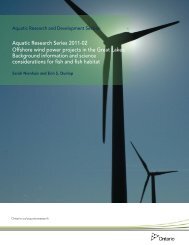Ontario's Natural Heritage Areas - Ministry of Natural Resources
Ontario's Natural Heritage Areas - Ministry of Natural Resources
Ontario's Natural Heritage Areas - Ministry of Natural Resources
You also want an ePaper? Increase the reach of your titles
YUMPU automatically turns print PDFs into web optimized ePapers that Google loves.
The Ontario IBP/CT work helped define and<br />
strengthen protection policies for Provincial Parks, and<br />
provided a list <strong>of</strong> candidate sites that have been used<br />
for various environmental assessment and land-use<br />
planning initiatives, including the Niagara Escarpment<br />
Plan and regional <strong>of</strong>ficial policy plans prepared under<br />
the Planning Act. Today, International Biological<br />
Programme Sites are represented within most <strong>of</strong> the<br />
protected categories covered in this report. As the first<br />
methodical assessment <strong>of</strong> natural areas in Ontario, the<br />
IBP survey remains an important information source for<br />
various environmental interests involved in identifying<br />
natural areas for conservation.<br />
Protection Goal and/or Objectives<br />
Overall, the goal <strong>of</strong> IBP/CT was to conduct a worldwide<br />
inventory and assessment on the status <strong>of</strong> ecosystem<br />
representation in protected areas. The aim <strong>of</strong> this<br />
inventory was to establish which ecosystems were<br />
adequately represented within existing protected<br />
areas, and which ecosystems still needed to be<br />
protected in order to fully represent world ecosystem<br />
types. Standardized protocols for characterizing and<br />
documenting IBP Sites included the adoption <strong>of</strong> a<br />
classification <strong>of</strong> world vegetation types (Fosberg, 1970)<br />
and the utilization <strong>of</strong> a standardized survey check-sheet<br />
(Peterken, 1970) to furnish an objective assessment <strong>of</strong><br />
protected areas that could guide future conservation<br />
efforts (Box 4-4). The survey also helped to document<br />
research needs in various ecosystem types and<br />
protected areas, and it provided a catalogue <strong>of</strong> areas<br />
that could assist with setting future research priorities.<br />
From a protection standpoint, proponents advocated<br />
Box 4-4. Contents <strong>of</strong> the IBP/CT check sheet<br />
for Ontario.<br />
• Site location, jurisdiction, and conservation status.<br />
• Geology, physiography, soil, and aquatic attributes.<br />
• Summary <strong>of</strong> vegetation and plant communities.<br />
• Typical and special floristic and faunistic features.<br />
• Supplementary ecological site assessment.<br />
• Site boundary and aerial photo vegetation<br />
mapping.<br />
• Concise essay <strong>of</strong> the site ecology and communities.<br />
• Date and surveyor(s) sign-<strong>of</strong>f.<br />
a high level <strong>of</strong> protection for International Biological<br />
Programme Sites to conserve biological diversity<br />
and to retain natural areas for scientific research and<br />
education. At an international level, this ideal emerged<br />
from the early alignment <strong>of</strong> the IBP effort with the<br />
IUCN movement on National Parks and Equivalent<br />
Reserves. This perspective was widely adopted in<br />
Canada, where a number <strong>of</strong> regional IBP associates,<br />
beginning with advocates in British Columbia,<br />
promoted the establishment <strong>of</strong> specific legislation<br />
for ‘Ecological Reserves’ as the preferred means to<br />
protect International Biological Programme Sites<br />
for conservation, scientific research, and education<br />
(Franson, 1972, 1975; McLaren and Petersen, 1975).<br />
The British Columbia Ecological Reserves Act <strong>of</strong><br />
1971 was used as a model and by 1985 all provinces<br />
except Ontario and PEI had developed specific<br />
legislation for Ecological Reserves (Taschereau, 1985).<br />
Ontario elected to protect IBP Sites within Nature<br />
Reserve Parks, Nature Reserve Zones in other types<br />
<strong>of</strong> Provincial Parks, and various other conservation<br />
designations. However, the recent passage <strong>of</strong> the new<br />
Provincial Parks and Conservation Reserves Act now<br />
provides for protection policies that are comparable to<br />
the initial goal and objectives <strong>of</strong> IBP/CT and legislation<br />
for Ecological Reserves in other provinces.<br />
Selection Criteria<br />
In Ontario, IBP Sites were identified using criteria<br />
established by the International Biological Programme<br />
to complete a global list <strong>of</strong> protected and unprotected<br />
sites:<br />
(a) “<strong>Areas</strong> should, taken together, contain adequate and<br />
manageable examples <strong>of</strong> the entire range <strong>of</strong> major<br />
ecological formations or ecosystems in the world and<br />
illustrate the range <strong>of</strong> variation within each.<br />
(b) The Series should include sites which, although they<br />
do not qualify for inclusion under the first criterion,<br />
support species <strong>of</strong> plants and animals <strong>of</strong> outstanding<br />
interest or great rarity.<br />
(c) The series should include sites which are <strong>of</strong> scientific<br />
interest because <strong>of</strong> the human management to which<br />
they have been subjected, even if this has in some<br />
cases led to more or less far-reaching modification <strong>of</strong><br />
the biota.<br />
83 Ontario’s <strong>Natural</strong> <strong>Heritage</strong> <strong>Areas</strong>

















